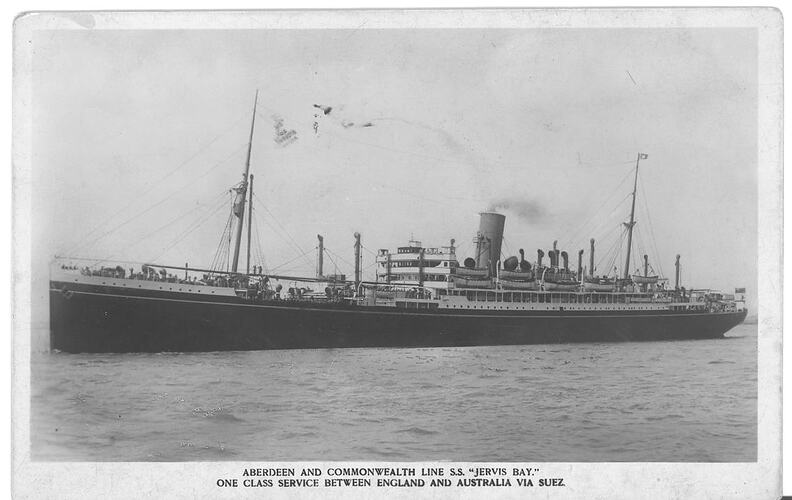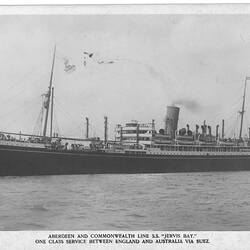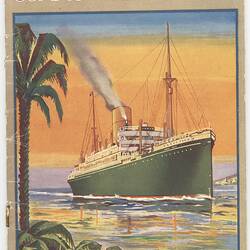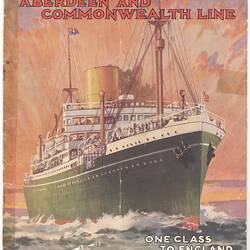The Jervis Bay (13,837 GRT) was the last of five 'Bay' cargo-passenger liners built for the Commonwealth Government Line in the early 1920s primarily for use on the United Kingdom to Australia shipping route to encourage assisted migration and increase capacity for the export of Austalian produce. The TSS Jervis Bay was launched from the Vickers Limited shipyard at Barrow-in-Furness in north-west England on 18th January 1922, slipping quietly into the water with no official ceremony. Measuring 530 ft (161.5 m) in length x 68 ft (20.7 m) beam x 43 ft 6 in (13.25 m) depth and drawing 29 ft 11½ in (9.13 m), the Jervis Bay displaced 23,320 tons (21,155 tonnes) and was equipped with 9,000 horsepower Parsons geared steam turbines driving twin screws, giving a service speed 15 knots (27.8 km/hr) fully loaded. The vessel's passenger accommodation was originally configured for 723 third class passengers (in cabins of two, four & six berths) and up to 12 first class passengers in six two berth cabins (which were reserved primarily for use by Government officials). Crew accommodation complied with the requirements of the Australian Navigation Act of 1921, which allowed far superior quarters than were typically provided on British registered vessels of the period. The Jervis Bay was also equipped with six cargo holds including extensive refrigerated space designed specifically for frozen meat, dairy produce and fresh fruit exports. The total cost of the vessel was approximately £1,250,000.
Fit out of the Jervis Bay was delayed by a shipbuilding workers' strike causing the date for her maiden voyage to be put back at least twice, but the vessel finally left London for the first time on 26th September 1922, sailing via the Suez Canal and Colombo under Captain W.R. Chalpin (- it is not recorded whether the Chaplin was Rev Captain). The Jervis Bay reached Fremantle early on 27th October disembarking 113 passengers, plus general cargo and mails, before proceding to the Eastern States later the same day. She reached Port Melbourne on 2nd November, berthing at Prince's Pier where 231 passengers disembarked, and Sydney on 6th November, where the final 325 passengers were landed.
In September 1926 Jervis Bay became the first ship on the UK to Australia route to be equipped with a short-wave radio transmitter - a self-oscillator type using two Marconi T250 valves enabling the ship to be in constant radio-to-shore contact.
As with her four sister ships, the sailing schedule of the Jervis Bay was repeatedly interrupted by industrial disputes amongst the staunchly unionised Australian crew and waterside workforce at Australian ports. After steadily mounting losses, the Austalian Government decided to sell all five ships to the British-owned Kylsant shipping group for £2 million, less than one-third of their original cost. The Jervis Bay was the last of the vessels to be transferred to new ownership, departing Fremantle on her last voyage to England with an Australian crew on 16th June 1928, after being delayed by strikes and other industrial action at every port.
The five ships contonued to operate their previous service with Britsh crews under the Aberdeen & Commonwealth Line. Following the outbreak of the Second World War in 1939, Jervis Bay was converted to an Armed Merchant Cruiser (AMC) at St Johns, Canada and used for patrol and convoy escort duties by the Royal Navy. The ship had been strengthened during her construction to carry eight six-inch guns.
On 5 November 1940, HMS Jervis Bay was sunk in the Atlantic by the German pocket battleship Admiral Scheer after the convoy Jervis Bay was escorting came under attack. Jervis Bay turned toward the Admiral Scheer and diverted her fire while the 38 ship convoy HX84 which included the cargo liner Rangitiki escaped. Her captain, E.F.S Fegan (a former commanding officer at the RAN College at Jervis Bay) was killed and the ship sank with the loss of 198 men. Fegan received a posthumous Victoria Cross for his actions during this engagement. Five ships from the convoy were sunk by the Scheer but most were able to escape. One merchant ship, the Swedish registered Stureholm turned back and was able to rescue 65 officers and men from the Jervis Bay.
More Information
-
Keywords
-
Localities
-
Authors
-
Article types





